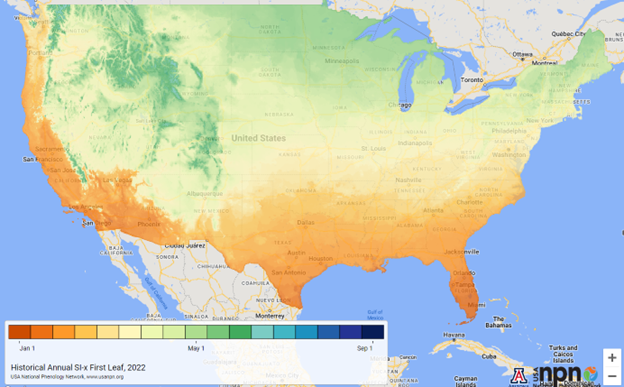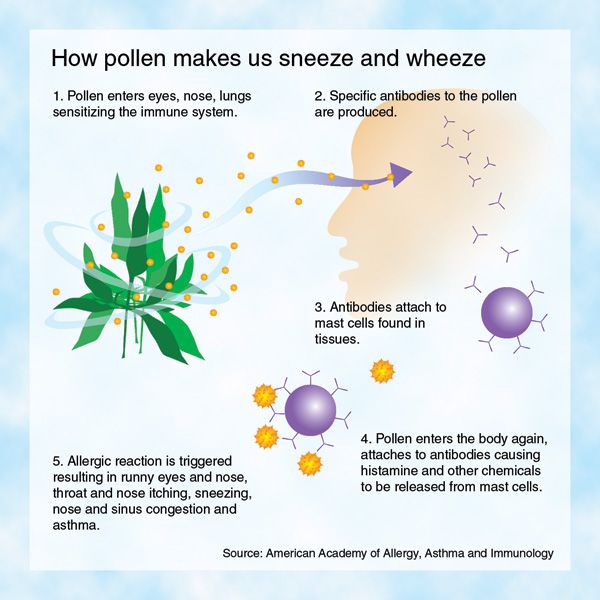Spring Pollen Season is Getting Longer & More Intense

Figure: This map from the USA National Phenology Network (USA-NPN) shows when springtime activity in plants typically began over the last 30 years based on pollen monitoring stations certified by the American Academy of Allergy, Asthma & Immunology National Allergy Bureau. The start of spring occurs on the date when enough heat has accumulated to initiate growth (leafing and flowering) in temperature-sensitive plants. The United States Global Change Research Program uses data from the USA-NPN Network as an indicator for start of the spring season.
Our changing climate has caused shifts in precipitation patterns, more frost-free days, warmer seasonal air temperatures, and more carbon dioxide (CO2) in the atmosphere. These changes may lead to both higher pollen concentrations and earlier and longer pollen seasons. Overall, data from the USA National Phenology Network (shown on the map to the left) indicates that on average, the start of spring has occurred earlier in the contiguous United States since 1984. found that nationwide, total pollen amounts increased up to 21% between 1990 and 2018, with the greatest increases recorded in Texas and the Midwest. One study found that nationwide, total pollen amounts increased up to 21% between 1990 and 2018, with the greatest increases recorded in Texas and the Midwest. Some of these changes in pollen due to climate change could have major impacts on human health such as increasing individuals’ exposure to pollen and their risk of having allergy and/or asthma symptoms.
Figure: This map from the American Academy of Allergy, Asthma & Immunology’s National Allergy Bureau shows where the pollen monitoring stations are located across the country.
Start of Spring Across the United States as of May 1, 2024

Figure: This map depicts where springtime biological activity began earlier than average (red tones) and later than average (blue tones) this year. We can expect an earlier start to the pollen season in regions experiencing an earlier than normal start to spring. For more information, visit the USA-NPN Status of Spring page.
Spring 2024 has now arrived in all but the most northern and highest elevation parts of the U.S. Spring spread quickly in the central and eastern parts of the U.S., arriving up to three weeks early in some states, before it has slowed once again in the Midwest. Currently, spring is 3 days early in Duluth, MN, 7 days early in Marquette, MI, and 3 days early in Caribou, ME compared to a long-term average of 1991-2020. The Sacramento Valley, coastal areas of Northern California, Oregon, Washington, parts of the Great Plains, and southern Midwest are seeing the earliest start to spring on record.
Springtime pollen release is heavily shaped by winter and spring temperatures. Plants must be exposed to sufficient warmth to emerge from dormancy, open their flowers, and release pollen. On average, plants release pollen about two weeks after showing signs of springtime activity.
Dr. Stanley Fineman from Atlanta Allergy and Asthma has been practicing allergy medicine for over 40 years and has seen firsthand the impacts of a warming climate on patients allergic to pollen. The pollen season has been starting earlier and lasting longer, leading to higher pollen counts and more intense allergy symptoms that last for longer periods of time.
Dr. Fineman reflected on how these changes to the pollen season have impacted his work:
“I had suggested that patients begin using their allergy medication, such as topical nasal corticosteroids, beginning St. Patrick's Day (March 17th), prior to the peak pollen season. Now I recommend that patients start their medications on Valentine's Day (February 14th).”
In addition to taking allergy medications earlier in the season, Dr. Fineman recommends that patients follow local pollen counts. Those who experience pollen allergies should limit their outdoor activities when pollen counts are high in their area.
Pollen Affects Health in Many Ways
Pollen is an airborne allergen that can affect our health. Pollen exposure can trigger various allergic reactions, including:
- Sneezing, runny nose, and congestion.
- Red, watery, or itchy eyes.
- Asthma or other respiratory illness exacerbation.
These symptoms have been linked to negative impacts on sleep, daily activities, productivity, concentration, and quality of life. Allergic asthma and seasonal allergies affect approximately 40% of the U.S. population.

The Centers for Disease Control and Prevention’s Pollen and Your Health site has information on how those with allergies or asthma can minimize pollen exposure.
The Food and Drug Administration’s Allergy Relief for Your Child site has information on allergy medications and shots for children and how to avoid pollen and other allergy triggers. The Seasonal Allergies: Which Medication is Right for You site has information on different allergy medications for all ages.
The National Institutes of Health National Center for Complementary and Integrative Health has helpful tips on additional approaches you can take to manage your allergy symptoms alongside medications and other therapies.
The USA National Phenology Network’s Status of Spring tracker shows the progression of the start of spring across the country and how the current year compares to previous years. The American Academy of Allergy, Asthma & Immunology National Allergy Bureau’s map shows stations across the United States that monitor pollen levels and provide allergen reports.
